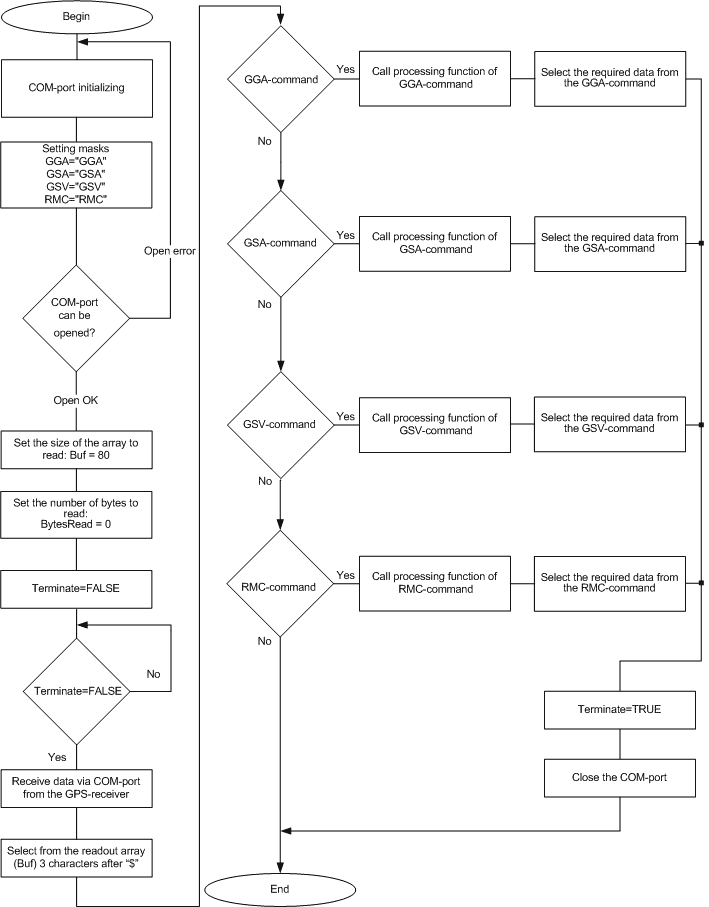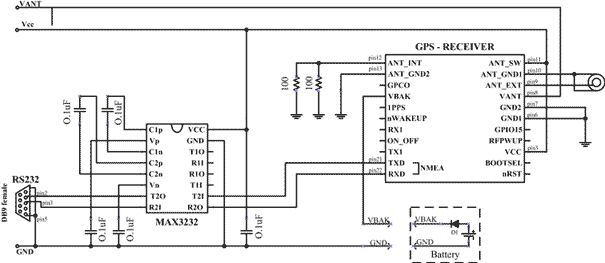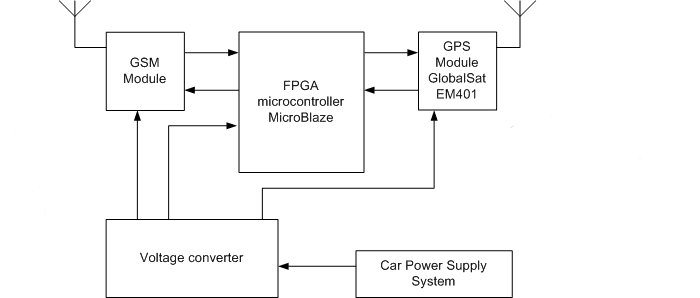 |
|
|
|
 |
|
 |
|
|||||||||||
|
|
|
|||||||||||||||||
 |
|
|||||||||||||||||
|
|
|
|||||||||||||||||
|
|
|
|||||||||||||||||
|
|
|
|||||||||||||||||
Medvediev Kyrylo
Computer Science and Technologies Faculty
|
|
|||||||||||||||||
|
|
|
|||||||||||||||||
|
|
|
|||||||||||||||||
|
|
|
|||||||||||||||||
|
||||||||||||||||||
Beginning of string |
The ID of the string address |
Empty field or data field
|
...
|
Empty field or data field
|
Optional checksum field
|
End of string
|
"$" HEX 24 |
'address field' |
[","+
'data field'
]
|
...
|
[","+
'data field'
]
|
["*"+
'checksum field'
]
|
'CR''LF' Hex 0D 0A
|
Used GPS-module EM401 provides a continuous state of the four main outputs NMEA command: GGA, GSA, GSV and RMC, which contain key information about the location, time, quality of data; displayed mode of GPS-receiver; determined the number of used and visible satellites, their numbers and parameters that are used in the solution of navigational problems.
Examples of messages:
- $GPGGA, 161229.487,3723.2475,N, 12158.3416,W, 1,07,1.0,9.0,M, ,M,0000*18
- $GPGSA, A,3,07,02,26,27,09,04,15,,,,,,1.8,1.0,1.5*33
- $GPGSV, 2,1,07,07,79,048,42,02,51,062,43,26,36,256,42,27,27,138,42*71
- $GPRMC, 161229.487,A,3723.2475,N,12158.3416,W,0.13,309.62,120598,,*10 [7]
Summing up , the algorithm can be divided into two main phases:
- Catch, reading and receiving NMEA-commands from the selected COM port.
- A breakdown of NMEA-commands and the choice of necessary data.

Picture 3 - Scheme of data processing GPS-module
Construction of the interface matching circuits GPS-Receiver GlobalSat EM401 with a microcontroller MICROBLAZE
To synchronization of all modules, and program management of the software is using the microcontroller MICROBLAZE. The microcontroller software is implemented on FPGA.
The main way to exchange information between modules of security complex is the transfer through a COM port. The difficulty is that the reception-transmission through it requires strict compliance with RS-232, according to which a high signal level corresponds to a voltage 3 .. +15 V, and the lower -3 ..- 15 V. In turn, GPS module uses a low power supply - 3.3 V, while data is transferred to the low voltage levels - Low Voltage TTL, which levels of signal do not exceed + -1.5 V. Therefore, for consistency, you can use IC MAX232 or MAX3232, which harmonize stress levels to 5 V and 3.3 V, respectively [1].
In the project using the COM port is more preferable than USB. This is primarily due to the fact that the board 3E Development KIT has two COM ports for interfacing with other devices. The second advantage is that the NMEA-protocol which are used by GPS-receiver GlobalSat EM401 for data transmission is compatible with RS-232.
The basic detail of the interface matching circuits GPS-Receiver GlobalSat EM401 with a microcontroller chip MICROBLAZE is MAXIM 3232. It is commonly used the converter levels of signals to TTL-CMOS voltage range 3 .. 5.5 V. It is equipped with proprietary output stages of transmitters, which provide low voltage drop and full compatibility with the requirements of the standard RS-232 at a supply voltage from 3,0 to 5,5 V. The formation of the output signal when using a single positive voltage supply is provided with two built-in pump generator. This device contains two receivers and two transmitters [12].
Wiring diagram for GlobalSat EM401 to COM-port of the microcontroller is shown in Picture 4 [1].

Picture 4 - Wiring diagram for GPS-module to a COM-port
The second an important element of the interface matching circuits is linear voltage stabilizer LM7805 (domestic analogue - KR142EN5) [13].
After soldering all the elements in the development board has been received interface matching circuits GPS-Receiver GlobalSat EM401 with a microcontroller MICROBLAZE, shown in picture 5.

Picture 5 - The interface circuit matching
Conclusion
During the implementation masters work was studied the problem developing the structure of the navigation system based on FPGA-technology.
Work with the hardware - a very complicated and laborious process, requiring high moral and material costs, so the process of debugging the project with using the debug board is still ongoing.
Links
1. Grudinin A.A. Pohomov A.A., Medvedev K.V., Zinchenko E.Y., Medgaus A.I. Zinchenko J.E.; report "Car alarm system based on GSM/GPS/FPGA"; Information and computer technology - 2010 // collection materials of the sixth international scientific conference of students, graduates and young scientists - Donetsk, Donetsk National Technical University - 2010.
2. User's guide for GPS-receiver GlobalSat EM-401. // web-resource
http://www.sparkfun.com/datasheets/GPS/EM-401%20User%20Manual.pdf
3. Gaymore I., "New family of GSM/GPRS/EDGE/GPS module of the company Siemens, targeted at automotive applications", Journal "Wireless technologies" ¹ 2, 2008. // web-resource
http://www.wireless-e.ru/articles/modules/2008_2_14.php
4. Dempster A.G., Parkinson K.J., Engel F., Mumford P., Rizos Ñ.; The UNSW/NICTA FPGA-based GPS Receiver: A Tool for GNSS Research; General Dynamics // web-resource
http://www.dynamics.co.nz/media/V1/indicon2005.pdf
5. Article in Wikipedia about RS-232 // web-resource
http://en.wikipedia.org/wiki/RS-232
6. Protocol NMEA and control command of GlobalSat GPS-receivers // web-resource
http://fort21.ru/download/protocol_nmea.pdf
7. Reference manual NMEA-commands for the SiRF-devices// web-resource
http://www.sparkfun.com/datasheets/GPS/NMEA%20Reference%20Manual-Rev2.1-Dec07.pdf
8. Semenov Y.A.; wireless (radio) channels and network // web-resource
http://web.opennet.ru/docs/RUS/inet_book/3/radio_33.html
9. Site, that devoted to patterns of vector graphics // web-resource
http://www.grafikerler.net/telefon-vektorleri-t51406.html
10. Darius; "Cheap and used Sirf II e LP GPS Module"; blog, dedicated to various projects in the electronics design software.
http://www.electronicsblog.net/cheap-and-used-sirf-ii-e-lp-gps-module-from-ebay/
11. Detailed description of the architecture chipset SiRFstarII. // web-resource
http://www.hotchips.org/archives/hc11/3_Tue/hc99.s7.3.Turetzky.pdf
12. MAX3232 Datasheet // web-resource
http://datasheets.maxim-ic.com/en/ds/MAX3222-MAX3241.pdf
13. LM7805 Datasheet // web-resource
http://www.avrlab.com/node/29
14. Description of program GPSDiag that monitor incoming NMEA GPS-messages from the serial port; the official site of the developer // web-resource
http://commlinx.com.au/
15. Description of , schematic diagrams, documentation, security systems, GSM-on GSM-network (for stationary and mobile offering). // web-resource
http://www.wrjob.org.ru/guard.html#
Important note
This master's work has not completed yet. Final Completion: November 2011. Full text of the work and materials on the subject can be obtained from the author or his supervisor after the specified date.

